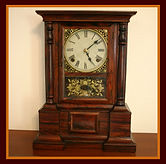
History of Clocks
 |  |  |
|---|---|---|
 |  |  |
 |  |  |
 |  |  |
A Brief History of Clocks
The first known time keeping devices were Sundial (Shadow) Clocks and Water Clocks. Sundial (Shadow) Clocks were invented by the Egyptians, and date to around 1500 BC. The Egyptians divided the day into 12 hour periods to measure time. Water Clocks (clepsydra) use a regulated flow of liquid into or out of a vessel to measure time. Many civilizations used Water Clocks including the Egyptians, Greeks, Babylonians, Persians, Indians and Chinese. They date to at least 1600 BC, however some evidence, which is still pending scientific consensus, suggests they might have been used in China as early as 4000 BC.
Candle Clocks have a known rate of burning and were used to measure the passage of time. They were mainly used indoors, at night, or on overcast days. It is not known when or where they were actually invented, however the earliest documented reference is from a Chinese poem by You Jiangu in 520 AD.
The origin of the hourglass (or sandglass, sand timer, sand clock or egg timer) is not known. The first record of the hourglass dates to the 700s when it was documented by a Frankish monk named Liutprand. This timekeeping devise is designed with two glass bulbs connected vertically by a narrow neck which allow a regulated substance (usually sand) to flow from the upper bulb to the lower to measure the passage of time.
The main problem with these early timekeeping devices was their limitations of use and inherent inaccuracy. The development of mechanical timekeeping devices drastically improved timekeeping accuracy.
Around 1300, the first true mechanical clocks began appearing in Europe. The verge (or crown wheel) escapement is the earliest known type of mechanical escapement. Its origin is unknown. The verge escapement is the mechanism in a mechanical clock that controls its rate by allowing the gear train to advance at regular intervals (it produces the ticking sound of a mechanical clock). The verge escapement is credited as the catalyst for the invention of the first mechanical clocks and was employed with a foliot or balance wheel which resulted in accurate timekeeping. The first examples of mechanical clocks were large devices, often built in tall towers, which included heavy weights that drove the hands of the clock. They were able to keep relatively good time for long periods.
Around 1602, Galileo Galilei demonstrated that swinging pendulums could be used in a clock movement to regulate timekeeping.
In 1656, Christiaan Huygens expanded on Galileo’s earlier pendulum work and invented the first pendulum clock. The balance spring was one of Huygens’ key developments in the progression of pendulum clock designs. (Historically there is a debate on whether Robert Hook invented the balance spring before Huygens.) The pendulum clock proved to be more accurate than earlier clocks and became popular throughout Europe. Pendulum clocks remained one of the most popular and accurate clock designs well into the 20th Century.
In 1927, Warren Marrison and J.W. Horton built the first quartz clock, which work quite differently than pendulum clocks. Quartz clocks measure the passing of time through a quartz crystal instead of a pendulum. The quartz clock proved to be more stable in various environments and was more accurate than the pendulum clocks.
By the 1980s, quartz technology became the most dominate timekeeping technology in the world for both clocks and watches.
Atomic clocks are the most accurate timekeeping devise ever invented, and are used to calibrate other clocks and to calculate the International Atomic Time; a standardized civil system. Currently, the world’s most precise atomic clock (which can measure time to the closest hundred trillionth of a second) was built by the National Institute of Standard and Technology together with the University of Colorado, Boulder.
A Collection of Various Types of Clocks
cuckoo clocks
Originally produced in the early 1700s Cuckoo clocks are typically a pendulum-regulated clock that strikes the hours with a sound like a common cuckoo's call and has an automated cuckoo bird that moves with each strike of the hour and once on the half hour.
Grandfather (Tall case) clocks
A grandfather clock (also referred to as a longcase clock, tall-case clock, or floor clock) is a tall, freestanding, weight-driven pendulum clock commonly 6 to 8 feet tall. The English clockmaker William Clement is credited with the development of this form of clock around 1680.
nautical clocks
Nautical clocks were necessary for safe sailing before modern technology and the invention of GPS. This form of clock was invented in the 18th century. They provided the main time and weather information for a ship's captain and crew, and in additon to being a precision timepiece they often included a thermometer and a barometer, and sometimes a tide monitor.
shelf clocks
Shelf clocks (can also be categorized as Mantle clocks) are traditionally placed on the shelf and can be highly ornate and decorative works. Simon Willard popularized the economical shelf clock (half clock or Massachusetts shelf clock).
scrool & pillar clocks
Scroll &Pillar clocks were patented in 1823 by Eli Terry. Mass-production began in the United States in the 1820s. Their rectangular case is topped by a scroll broken in the center by an ornament such as an urn; on either side of the case is a vertical pillar topped by the same kind of ornament that breaks the scroll.
Interesting Articles About Clocks and Timekeeping
A Brief History of Timekeeping
Acknowledging Scottish Clockmaker John Bower (1761-ca, 1830)
Custom-made grandfather clock brings Lebanon County history to life
History and Preservation of Daytona Beach's Unique Coquina Clock Tower
Life and Times of the GMK-Fancer Clock Company
Revealing the Unique History of Lebanon County, Pennsylvania, Clockmakers
Time Detectives - Discovering the History of Railway Clocks
The Physics Of Why Timekeeping First Failed In The Americas












